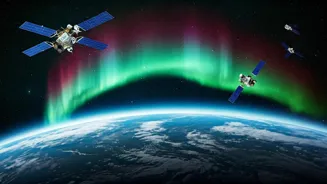Understanding Space Weather
Space weather encompasses the conditions in space that can affect Earth and its surroundings. The Sun, a dynamic star, is the primary driver of space weather,
releasing energy in the form of solar flares, coronal mass ejections (CMEs), and solar wind. These events can have a wide range of impacts, including disrupting satellite communications, damaging power grids, and posing radiation hazards to astronauts. Space weather events can lead to auroras, but also can create havoc with technologies on Earth, making it critical to observe and anticipate these occurrences. NASA and other space agencies are constantly developing new methods to measure and forecast space weather events. Such monitoring is crucial for ensuring the security of our technological systems and protecting astronauts in space.
IMAP: A Comprehensive Look
The Interstellar Mapping and Acceleration Probe (IMAP) mission is designed to investigate the boundary of the heliosphere, the bubble of space created by the solar wind, and the interstellar medium beyond. IMAP will map the region where the solar wind meets the interstellar medium, studying how solar particles and interstellar particles interact. By doing so, IMAP will enhance our understanding of space weather by providing insights into the solar wind's behavior and its effects. This data is crucial for refining space weather models and for forecasting space weather conditions. IMAP's measurements should improve the predictions for solar storms and their impact on Earth and human operations in space, protecting our satellites and other space assets.
CGO: Tracking Geomagnetic Storms
The Compact Geosynchronous Orbit (CGO) mission is focused on studying Earth's magnetosphere and its interaction with the solar wind. This includes monitoring geomagnetic storms, which can disrupt satellite operations and cause power grid failures. The CGO mission will monitor the Earth's magnetic environment in real-time. The data collected by CGO provides essential information for space weather forecasting. By precisely mapping these events, scientists can provide warnings to mitigate the effects of the storms on satellites and ground-based infrastructure. CGO’s continuous monitoring can provide alerts about potentially hazardous space weather. The real-time data supports the safety of critical services like GPS and communications by forecasting when these disruptions are most likely to happen.
SWFO-L1: Real-time Monitoring
The Space Weather Follow On-L1 (SWFO-L1) mission is crucial for real-time space weather monitoring, providing continuous observations of the sun and the solar wind. SWFO-L1 is designed to detect and characterize solar events, such as CMEs, that can impact Earth. This mission provides advanced warning of space weather events, enabling actions to safeguard satellites, infrastructure, and astronauts. SWFO-L1 is equipped with advanced instruments to measure solar flares and CMEs. These real-time measurements allow scientists to track space weather activity and predict its potential effects on Earth. The data enables quick response, so potential damage from these storms is minimized, and it is essential for protecting sensitive technological systems.
Importance of Monitoring
Monitoring space weather is critical for protecting human life and technological infrastructure. Accurate forecasts can help protect astronauts from dangerous radiation exposure during space missions. Satellites are also susceptible to space weather events, which can disrupt communications, navigation, and Earth observations. Furthermore, space weather can affect power grids, causing blackouts and other disturbances. Understanding and predicting these events is essential for safeguarding our interconnected world. The monitoring helps in the early detection of solar flares and CMEs, allowing for prompt reactions to limit disruption.
Future of Space Weather
The future of space weather research involves advanced monitoring and forecasting capabilities. NASA and other space agencies are investing in new technologies to enhance their understanding of the sun and its effects on Earth. Advanced modeling tools are being developed to predict space weather events with greater accuracy. The data from missions like IMAP, CGO, and SWFO-L1 will feed these models. International collaboration is another key element, as different space agencies work together to share data and knowledge. These advances are improving our ability to protect our planet from the impacts of space weather events, making space travel safer and protecting our technology.



